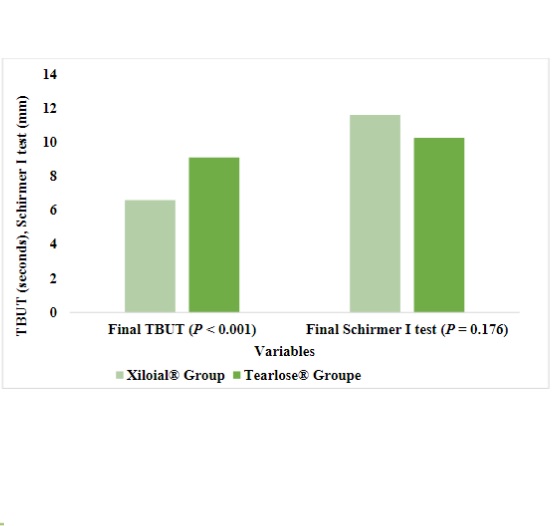The effect of tamarind seed polysaccharide containing eye drop in dry eye syndrome: Results of an interventional, comparative, clinical study
Medical hypothesis, discovery & innovation in optometry,
Vol. 2 No. 2 (2021),
21 November 2021
,
Page 71-76
https://doi.org/10.51329/mehdioptometry128
Abstract
Background: The mainstay of dry eye treatment is artificial tear solutions. Contralateral eye comparison of 2 types of artificial tears (Xiloial; tamarind seed polysaccharide-containing lubricant eye drop versus Tearlose) in managing dry eye disease was sought in this study.Methods: This study was a prospective, interventional, contralateral eye comparison of 2 types of artificial tears used for managing dry eye disease. The study participants were categorized into mild (13–22 points), moderate (23–32 points), or severe (33–100 points) ocular surface disease according to the baseline ocular surface disease index (OSDI) questionnaire score. Schirmer I and tear film break-up time (TBUT) tests, as well as detailed slit-lamp examinations, were performed at baseline and at the end of the study. All participants received Xiloial monodose eye drops for the right eye and Tearlose eye drops for the left eye, administered as a single drop 4 times per day. Furthermore, they were instructed to perform lid hygiene every 12 hours per day for both eyes.
Results: Thirty-five patients (70 eyes) with a mean ± standard (SD) age of 50.2 ± 13.4 years were included, and 14 (40%) were men. The mean ± SD of the OSDI score was 44.24 ± 22.59 at baseline. Of the 35 patients, 10 (28.6%), 5 (14.3%), and 20 (57.1%) had mild, moderate, and severe ocular surface disease, respectively, according to the baseline OSDI score. Compared to baseline, the mean values of both TBUT and Schirmer I tests improved significantly in both groups (both P < 0.001). In comparing the final mean values between the 2 groups, this improvement was comparable for the Schirmer I test (P = 0.179), but TBUT in Tearlose-instilled eyes improved significantly more than in the fellow eyes (P < 0.001).
Conclusions: Both Xiloial and Tearlose eye drops improved tear stability and tear production after a 2 week treatment period in eyes with dry eye disease. This improvement was comparable for tear production, but Tearlose-instilled eyes showed significantly greater improvement in tear stability. Further studies with longer follow-up and larger sample sizes could provide more reliable results as a basis for the clinical use of this TSP-containing lubricant eye drop solution in dry eye disease.
Keywords:
- dry eye disease
- dysfunctional tear syndrome
- OSDI
- ocular surface disease index
- treatment
- artificial tear
- Xiloial
- Tearlose
- TSP
- tamarind seed polysaccharide

- Abstract Viewed: 43 times
- Full Text PDF Downloaded: 0 times